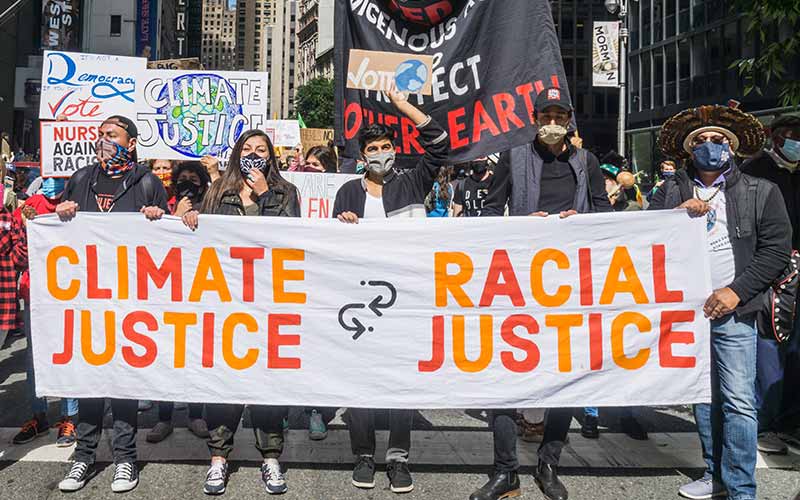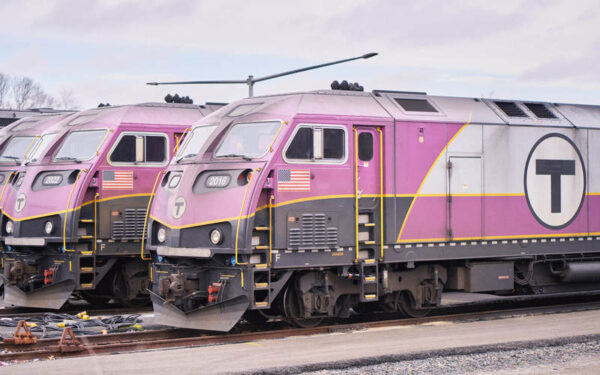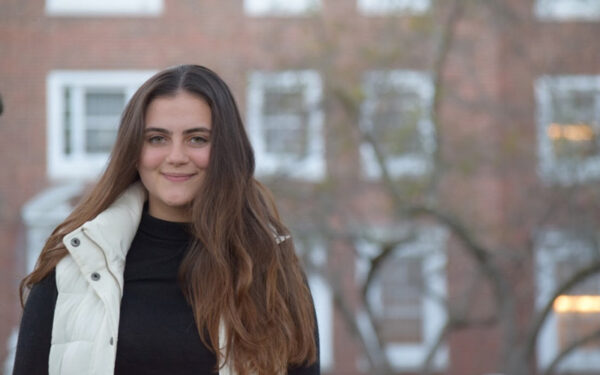
You can't separate environmental justice from racial justice. Photo Credit: Shutterstock
An earlier version of this article was posted in October 2020.
For decades, low-income, immigrant, and communities of color across New England have been overburdened by air pollution from power plants, congested highways, and industrial facilities. These same burdens resulted in COVID-19 and its associated economic crisis taking a much heavier toll on these communities than on their wealthier, whiter neighbors.
Discriminatory housing, zoning, and transportation policies have disenfranchised the residents here, denying them the power to shape their own neighborhoods. This directly harms resident health and well-being, stretching over generations.
To find out what needs to change to relieve these burdens, CLF connected with two of our Massachusetts-based partners – María Belén Power from GreenRoots and Andrea Nyamekye of Neighbor to Neighbor. Together with CLF Senior Attorney Staci Rubin, and facilitated by former Interim Director of CLF’s Healthy Communities & Environmental Justice Program Amy Laura Cahn, we spoke about what having strong environmental justice protections would mean for their communities.
Below is an excerpt from this conversation, edited for clarity.
What are environmental justice protections?
Andrea Nyamekye, Neighbor to Neighbor: Environmental justice means having the ability for folks to make decisions and be a part of decision-making processes that have to do with their immediate environment, their health, etc.
It gives [people] the ability to express self-determination and influence how they want their environment to look. Without [environmental justice], a lot of communities are consistently being pushed out of those decision-making processes – either because there’s a new facility [like a power plant] and nothing is translated in the language that they speak, or meetings are during the day when a lot of people are at work.
The really important part is ensuring that people can actually make decisions, and have decision-making power, in their communities.
María Belén Power, GreenRoots: When I think about self-determination, what comes to mind is the community actually being at the table. And just having basic rights, such as understanding what is being said, what is being approved. And, I would say in a larger picture, it is also the reversal of generations of environmental racism.
In some ways, [environmental justice] is doing the hard work of fixing the structures that have for so long been oppressive and racist and anti-low-income folks and anti-immigrant and anti-non-English speakers.
What does life look like without these protections?
Staci Rubin, CLF: Life without environmental justice protections looks like fossil fuel power plants in these communities. It looks like highways with single occupancy vehicles running through and dividing neighborhoods. It looks like people living under flight paths. It’s loud and difficult to breathe. It’s people not having access to green space to walk and bike and enjoy with families and friends. And, it looks like a place where people are literally sick and dying at higher rates because they are exposed to these cumulative burdens of environmental harm and energy [pollution].
María Belén Power, GreenRoots: I would add a couple things, just highlighting what Andrea said about self-determination and how decisions are made. I think specifically about the Eversource substation and how that was approved in a process that was not in the language of the community where the project is being sited. The meetings [for the project] never happened in that community until Eversource was forced to [hold them there].
How has racism contributed to environmental justice inequities?
María Belén Power, GreenRoots: Low-income communities and Black and Brown communities have been the sacrifice zones [so that] the rest of the region – and the country – have the benefits that industries bring.
I wasn’t working in Chelsea during this time, but the power plant fight [with Energy Management Inc. in 2007] is a good example. There was big disparity. The very same proponent that was proposing clean air for Nantucket through the Cape Wind project was proposing a dirty diesel power plant in Chelsea. That is a clear choice of where we are siting dirty industry and where we are siting clean energy infrastructure. So, who gets the benefit and who gets the burden?
That’s what we’re undoing [with environmental justice protections and the environmental justice movement]. We’re undoing the intentional siting of hazardous and polluting industries in communities that have already been, that already are, suffering from vulnerabilities of public health and access to transit and so many different burdens that are piling and piling and piling on.
What does environmental racism look like in our communities?
Andrea Nyamekye, Neighbor to Neighbor: I’ll use the chapters in which Neighbor to Neighbor organizes our “gateway cities of Massachusetts,” [as an example]. They’re all susceptible to the heat island effect [which is a huge public health problem]. Our Springfield chapter has the worst asthma rate in the nation. And I believe Holyoke has the second worst asthma in the State of Massachusetts, along with [high] child mortality and cancer [rates]. These things are not just by chance. They didn’t just pop up – but have been intentional. There’s been a lack of seeing these burdens in our communities.
I [also] want to bring up two campaigns that our Springfield folks and Holyoke folks did in the past years. And the first one is around the Gerena School tunnel. Gerena is a school in Springfield in a predominantly low-income and people of color neighborhood. Students have to walk through a tunnel under the highway to get to school, and the tunnel is filled with mold. It took us years just to [find] the right person who, in the State of Massachusetts, needs to clean up the mold in this tunnel.
The second is the Mt. Tom coal plant fight back in 2014. This coal plant had thousands of citations over decades, and it took a lot of community organizing saying, “You’re polluting our air and our water; this coal plant needs to shut down.” It took the uncovering of decades of citations to see that, like Springfield, Holyoke was getting the burden of all those impacts from the Mt. Tom coal plant.
María Belén Power, GreenRoots: Just to bring in the historical aspect: Andrea’s story reminded me of Chelsea’s history and how it went into receivership. Chelsea was the first city in the whole nation to go into receivership after the Great Depression. [The State] took over the schools, and they realized that they needed better schools – and a lot of the open space and green space was taken to build those schools. So, communities like Chelsea have had to face these really tough decisions: Do you get open space, or do you get schools? Which one do you want?
It shouldn’t have to come down to that, because people really need good schools. But also, the life-long impact of having accessible open space and green space is really important.
Environmental justice affects so many different areas of our lives. It’s not just about clean air. And it’s not just about clean water. It’s so much more intertwined with our basic needs. To have language justice, education, [and] transit. It has deep, deep consequences if we truly have those protections for communities of color, low-income communities, and communities where English is not the first language.
How has environmental racism impacted transportation?
Staci Rubin, CLF: You can look at which communities have really long commute times or [where people] are waiting for buses in environments that are not pleasant to be in – you know, loud spaces without a bench to sit on. Those are primarily communities of color and low-income communities. There, the transit systems were not designed to help service workers or low-wage workers get to work outside of a nine-to-five timeframe.
For so many generations, there were commuter rails that passed through low-income communities of color and didn’t actually stop to pick up or discharge passengers. The idea was to get people from white, wealthier suburbs far away from Boston into the city as quickly as possible, while the pollution from those trains was burdening the folks who live closer in and weren’t able to benefit from getting on the train.
So environmental justice protections in that context look like affordable fares, reliable transit, the opportunities to see zero-emission vehicles or electric vehicles so that there are no tailpipe emissions contributing to the burden. It’s people actually benefiting by getting access to a service that they can use and depend on to get where they need to go.
What we can, and should, do now.
All communities have the right to self-determination and a healthy environment. Residents – in Massachusetts and across New England – should have a voice in the projects impacting their neighborhoods. Government agencies must take a harder look at how and where dangerous facilities are placed. And state law must address the historic inequities baked into the system.
You can help. Contact your local state representative and tell them you support environmental justice legislation.
A version of this article was originally part of a series about environmental justice in Massachusetts and the critical work being done in the legislature to address it. Read the entire series here.
María Belén Power is the Associate Executive Director of GreenRoots, a community-based and resident-led environmental justice organization working in Chelsea and East Boston, Massachusetts.
Andrea Nyamekye is the Campaign and Policy Director at Neighbor to Neighbor, a Massachusetts-based grassroots power-building organization working to improve quality of life for local communities.
Staci Rubin is a Senior Attorney at CLF focusing on transportation advocacy and its intersection with public health and the climate crisis.




